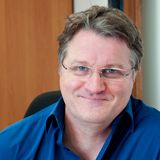
Professor Lloyd Hollenberg
Thomas Baker Chair, Australian Research Council Laureate Fellow, Deputy Director, Centre of Excellence for Quantum Computation and Communication Technology, School of Physics, Faculty of Science, University of Melbourne
See research profile
Sciences & Technology
The next big scientific thing
As National Science Week celebrates scientific discovery in Australia, we ask what’s likely to be the ‘next big thing’ in some of the most exciting fields of science research?

Sciences & Technology
Lifting the lid on quantum computing
Newly developed software for learning quantum computer programming allows students to see inside the ‘black box’ and start using the ‘weird’ physics to solve problems

Sciences & Technology
Special Report
Can you explain Quantum computing?
Quantum computing can be a challenging concept to get your head around - could you explain it?

Sciences & Technology
Special Report
So, you want to work in Quantum computing?
Like the evolution of classic computers in the 1940s, quantum computers are on the cusp of mainstream, and researchers, businesses and universities are already getting themselves quantum ready

Sciences & Technology
Special Report
What has Quantum ever done for me?
Much of quantum computing exists primarily in theory. Quantum sensing, however, is already here

Sciences & Technology
Special Report
Grasping the ‘spooky’ in Quantum physics
Quantum computing could stream-line financial calculations, optimise the workings of complex systems like logistical networks and enhance artificial intelligence. So how hard can it be?

Sciences & Technology
Special Report
Quantum leap in computer simulation
Physicists have successfully run the largest quantum computing simulation to date, a key step in becoming quantum-ready

Sciences & Technology
Special Report
Quantum boost for medical imaging
Physicists have demonstrated how, using light, a diamond layer and quantum mechanics, they could potentially “light up” our molecular insides for more powerful MRIs

Sciences & Technology
Seeing the electricity inside graphene for the first time
In the race towards faster and smarter next-generation electronics, including quantum computers, researchers at the University of Melbourne are the first in the world to image how electrons move in two-dimensional graphene
